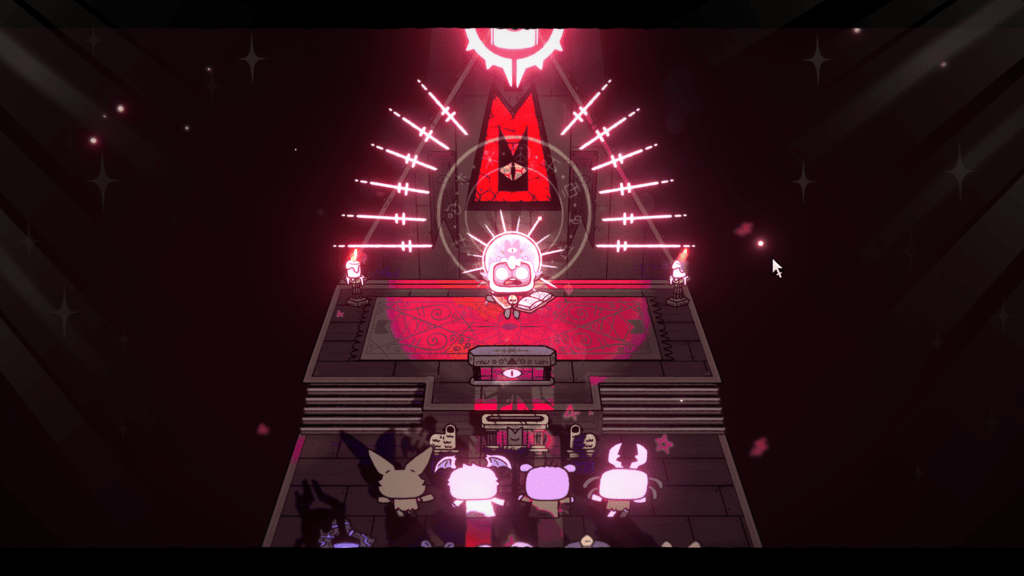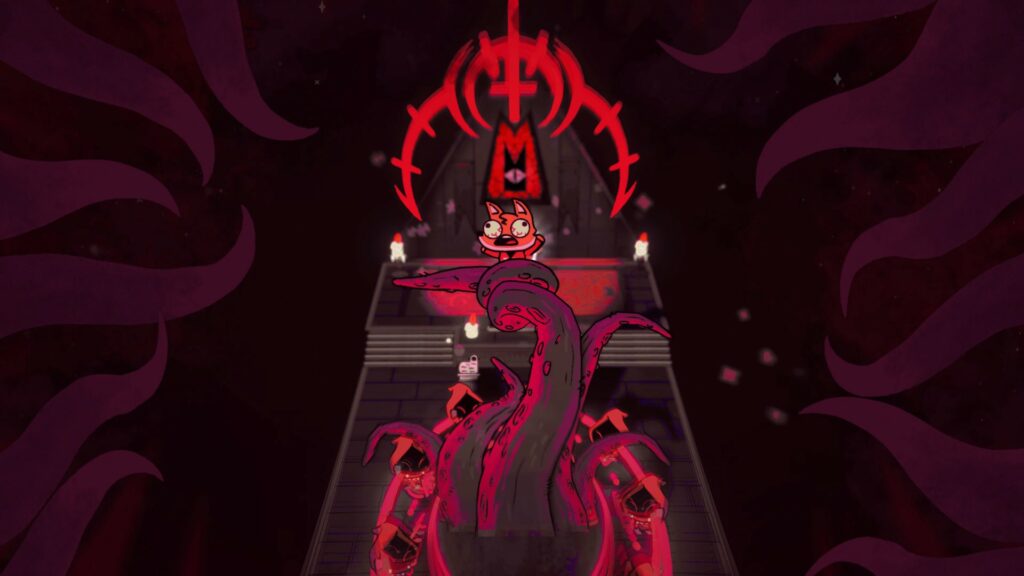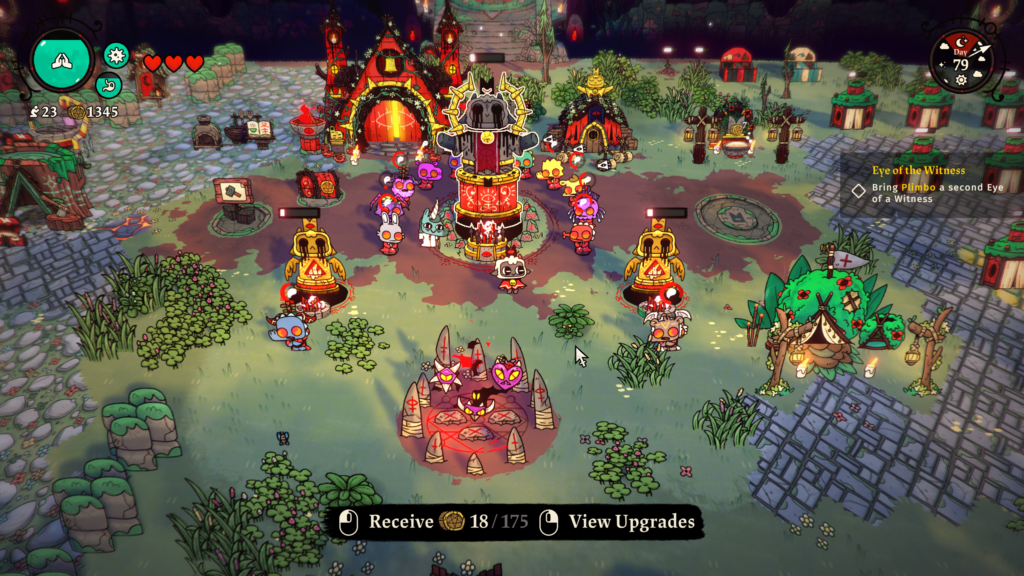You'll love it if:
- You want a fast and consistent gaming experience.
- Happy Tree Friends was your favourite show.
- You are a closeted psychopath looking for a legal outlet.
Not for you if:
- You want a gaming difficulty that spits in your face and calls you names.
- You're a radical animal rights activist.
- The phrase
So you’re here again. Let me guess, you saw the picture of the cute lamb on the cover and thought this was gonna be a wholesome experience. Well, I have news for you. This is not your average cutesy indie title about small animals having a great time. This is visceral, disturbing, and bloody. My kind of game in other words. Check your sensory deprivation tank, spike the food with psychedelics, and lure in as many naive and vulnerable people as you can because today…today you and I are joining a cult!

Cult of the Lamb: Review TL;DR
I never thought I’d ever say this about a game but Cult of the Lamb is like combining the movie Midsommar with Animal Crossing. Welcome to a cult management simulator with roguelite elements that’s gonna surprise, unnerve and probably charm you. The artistic direction is absolutely incredible. Coming from Massive Monsters studio’s classic Saturday morning cartoon art style is a game with horror elements that makes you feel like something is wrong even though you can’t really put your finger on it. The gameplay is responsive and satisfying. Nevertheless, the lack of depth will turn off some people that are really into complex gameplay mechanics. The soundscape is satisfactory by itself but gets elevated to oblivion because the music that follows it is absolutely brilliant. If you want to spend 20 hours abusing the trust of vulnerable people, treating your followers as literal resources, and decapitating ritually summoned monstrosities then rejoice! This game is for you.
The mark of the beast
I had my eyes on this game for a very long time. The story starts with me scouring Steam one day like I usually do. When I came upon the page of this game my interest peaked considering what I saw. But before that context is needed.
You see, I need to mention that I am a huge sucker for roguelites. I played whatever I could get my hands on, and since the beginning, I have never stopped. Left League of Legends, Dota, Apex, and a myriad of unhealthy habits behind to try to become a better person… Unfortunately, roguelites still keep pulling me back in like a bag of greasy and unhealthy fast-food after a drunk Friday bender at 3:00 in the morning. Oh, I know that they’re not good or healthy for me. I still can’t keep myself from sheepishly going back to whatever self-made hellhole I have put myself into and wasting hours just to taste the power trip that the perfect run will give me. This is also something that unfortunately bugged me about the game but let me not get too far ahead of myself yet. Since now you know what tingles my jingles it’s time to talk about the fresh new hotness on the block: Cult of the Lamb.

So after seeing the steam page and of course hungry for more pain and suffering, I added the game to my wishlist and waited. Patiently, like a good little cattle for what I would consider the proverbial slaughter. Thankfully, around two months later, the release was gloriously upon us giving me the chance to kill and mutilate as many cute animals as I could. With my robes ready, my candles lit and my ceremonial dagger sharpened, I started playing.
Rebirth and faith
The game starts with you, a cute little lamb, literally walking to the slaughter. Cultists surround you pointing sharp objects and forcing you to go to the very obvious 5-pointed star sacrificial circle, above which the four leaders of the old faith look down upon you. After giving a brief mention of some prophecy your head is swiftly put down on the block and given the good old Marie Antoinette with no further explanation. The screen goes black and you appear in what I would presume is the place that people, or in this case small little animals, go when they die. There, in the pure witness forged by the skulls of the dead lies your “benefactor”. His name is quite simply “The One Who Waits”.
He proposes a very simple deal. He, the ruler of death, will give you your life back in exchange for a very small thing…faith. You need to pledge your allegiance to him and find people that are like-minded, naive, or vulnerable in order to start a religious movement that quite simply worships The One Who Waits. Of course you accept and with the bargain struck receive the symbol of his power and conduit on the living world. A cute little eye-hat. No, I’m not joking, the hat actually has an eye on it.
With the correct tools provided and your bloodlust rekindled your purpose becomes more than clear. Create a cult to become powerful, find the 4 that killed you and put their severed heads on a pike outside your temple in case anyone wondered what happens if they defied you.
All images are either in-game screenshots or from the game’s Steam page.

Ethically dubious but aesthetically perfect
If I had to describe the visual style of the game in one word I think it would be “red”. Throughout all my experience the one constant that my eyes would perceive through each individual and changing environment was the colour red. This is by no means a complaint since they have a very good reason for this design choice. This specific colour represents the supernatural power invested in you by your “god”. Of course it appears on other items as well but it has a distinct presence in your rituals and otherworldly phenomena you might cause or stumble into. If you’re a big fan of horror, check out also Kostas Nikolaou amazing MADiSON review.


The larger question remains at large though. What separates Cult of the Lamb aesthetically from other games? What is that “je ne sais quoi” that will make your first experience playing the game special? The answer is simple: contradiction! The quality of the character sprites is for a lack of a better word, absolutely and disgustingly adorable. Wonderful little animal people that would appear on the TV screen on a Saturday morning while your child watches in jubilation. So what would your feelings be when the cute little capybara that you just rescued, gets literally drawn and quartered by eldritch tentacles while you shockingly realize that the item “Follower meat” is added to your inventory? I’ll tell you what mine was. An absolute delight for what I had stumbled into.

The power and soul of this game comes from that simple deception. You will commit the most disturbing atrocities while on your quest for revenge and if the characters were normal humans on a kind of realistic game you would be horrified. But just like me, you’re not. The cute sprites mask the disturbing reality of what your character has to actually do to progress. In a scenery straight out of a children’s storybook, your character will be sacrificing the older cultists to an otherworldly abomination just because you think it’d be a shame to let that resource die of old age and go to waste. That right there! That is the magical moment when you realize that your “flock”, these cutely drawn animal sprites, are nothing more than resources to you. That’s when you really become a cult leader.

Mechanics and Management
But what do you actually have to do for your cult to grow and prosper? Before answering that question I will mention that I will not be covering all the mechanics that the game offers. Firstly, because most of them have no impact on the story or significance for the cult, and secondly because, well, you’ll have to play the game to see some of them.
The secret of a great cult iiiiiiiiiis, drum roll please… you guessed it, micromanagement. This is unfortunately not a joke. You see I was very careful in my words when I described the game as a cult management simulator with roguelite elements. You will spend most of your time managing your cult and followers before anything else. Feeding, cleaning, and delegating tasks to them is what makes the cult machine go “choo choo!” on a daily basis.
“I’ve always kind of wanted to start a cult. So, you know, this is kind of my way into it.”
-Julian Wilton. Massive Monster’s Creative Director
A simple example is this. Did your followers find the dead body of one of their compatriots on the floor? Well, get ready because you’re about to face what I call “the Vomit Cascade”. The moment your cult members see something that disgusts them they will simply vomit right there and then. That in turn will make any other member that passes through that area vomit as well, making the area bigger and easier for other members to be disgusted. See where I’m going with this? Before you know it all the members of your cult will be violently expelling their stomach contents on the pavement while your sanitation bar will be going down faster than how quickly the economic inflation goes up in 2022. Order is required to sustain the faith. Those with weak stomachs will not survive.
If you want non-stop action and looting then you’ve come to the wrong place. In this game sometimes it’s actually more optimised to stay in your cult making everything run more efficiently instead of cracking heads with your hat-sword. Which brings me to combat.

Simple, efficient but ultimately repeating
Four were the betrayers that cast you in the land of the dead. Four are the temples that need to be destroyed. And four are the progression areas for combat in this game. With each and every bishop of the old faith that you slay, the next biome becomes unlocked and the more vicious the enemies become. But what is the crux of combat really? It’s simple. One button press for melee attack, one for spells, and one for dodge-rolls. It’s non-complicated, intuitive, and easy to learn. It is also unfortunately, in my opinion, a bit boring. The whole challenge of the game comes from your good dodge-rolls and reflexes. In other words, avoid projectiles and you’ll be marginally ok. Dodge, hit, dodge, hit and then rinse and repeat until there are no enemies left.
The differentiation between the runs comes from your equipment and cards. You see at the beginning of each run you can choose a specific kind of weapon and sorcery. These, although rarely exchangeable in a run, will characterise the play-style of your current expedition along with your choices of cards. Cards are stat buffs that you can acquire during a run resulting in noticeable power boosts. More health, for example, is a good basic choice at the beginning that will allow you to get away with some mistakes early on. These range from attack speed and movement speed buffs, all the way to more magic or even backlash damage when hit.

With this comes one of my problems with the game. The gameplay mechanics are not deep enough. What I personally need is the “God run”. A run when everything goes so perfectly that the only thing causing you distress is the fact that it’s gonna be over at some point. What this game is missing is that magical moment when you transcend mechanics and reach the point of roguelite godhood with the blessing of RNJesus. In other words, it’s missing the power trip that I so dearly love in my roguelites.
My other problem is the sprites. Don’t get me wrong, they are beautiful. But from a technical standpoint they are also difficult to manage in your combat experience. The enemy sprites are all in 2D. Having a very aesthetically pleasing appearance. What they don’t have is an easily detectable hitbox. When it comes to diagonal hit registration, you are more likely to guess if the hit will register than anything else. I have been burned more than one time thinking that my melee hit is on point just to realise that I’m actually stabbing the air. Although this was a frustrating problem, I have to mention that it doesn’t ruin the experience in a meaningful way. Just like a good bottle of wine, a bit of sourness gives it more of a character.
The chants of the faithful
There are not a lot of things to talk about when it comes to sound design in Cult of the Lamb. “Simple is best” for background soundscape summarises everything. What I have to talk about though is the soundtrack. River Boy knocks it out of the park, city, and then planet. Creating relaxing melodies while some of the vilest stuff is going on in the background. Songs consisting of xylophones, electric beats, and aerophonic instruments that I hadn’t even known existed make the music of Cult of the Lamb into something that is really unique and special.

Conclusion
I really want to thank Devolver Digital for this creation because this was more than a gaming experience for me. It was an outlet. Cult of the lamb allows you to put your “decent person” responsibilities on the side and have as much unethical fun as you want for around 20 hours. It looks beautiful and feels consistent for its price. Something that not a lot of games are nowadays. Supporting Massive Monster Games makes me really excited about what else they have in store for the gaming community.
Buy it, play it, indulge in it, and most of all enjoy it.
